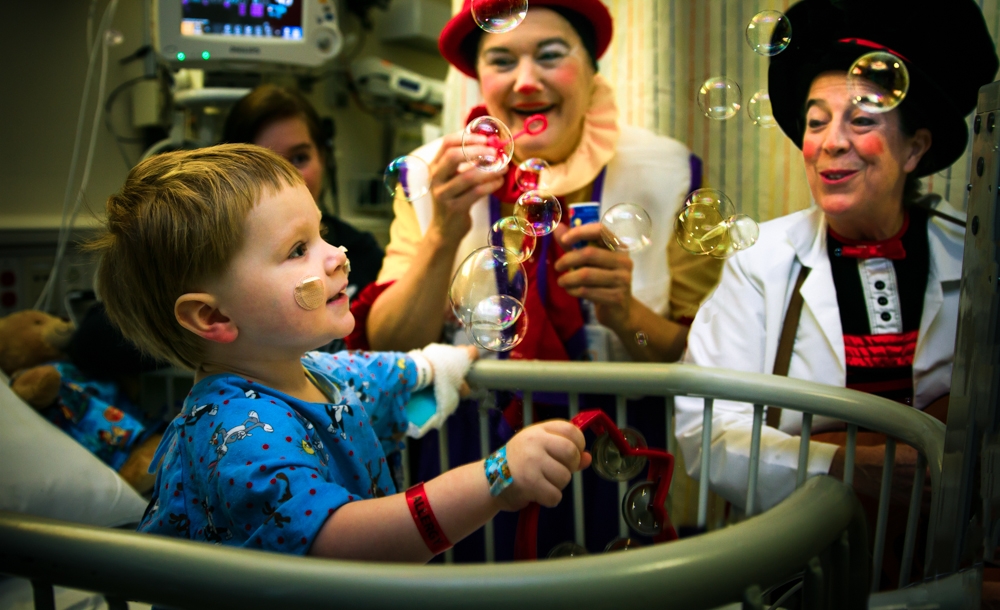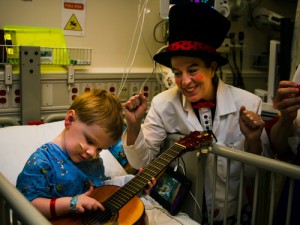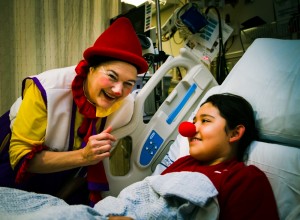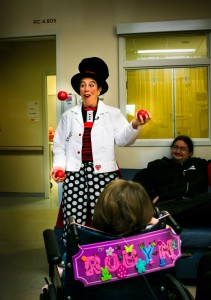
If you happen to stroll through Seattle Children’s Hospital’s medical or surgical unit on a Tuesday, you’ll notice something’s a little different – the air feels a little lighter. You’ll likely hear sounds of music and laughter flowing through the halls, and you may even encounter a juggling act.
The spirits of patients, families and staff are a little brighter on this day because of a couple of clowns. No really – a few actual clowns that are a part of the Room Circus Medical Clowning group.
Hanging out with the clown posse
I was recently lucky enough to get a chance to tag along with a few of the clowns during their visit at the hospital. In spending the day with Victoria Millard (aka Dr. LaFoo), who is executive artistic director of the group, and Linda Severt (aka Dr. Hamsterfuzz), who is the program manager, I witnessed firsthand the joy they brought to everyone they encountered – patients, parents and staff alike.
Whether they were blowing clown kisses to staff, playing new and improved elevator music, popping and locking while performing a clown rap for a teen patient, juggling or showing off their “stool” samples, you can’t help but smile when you watch them in action.

And a smile can make all the difference for a patient while they are in the hospital.
Especially for 5-year-old Oren Kendall, who particularly enjoyed a round of colored-scarf juggling. At the end of the spectacle, his mom thanked the clowns and said it was the first time she’d seen him smile in days, which is something the clowns hear quite often. Kendall then expressed his gratitude with multiple rounds of hugs.
For 2-year-old Karsten Hendricks, music was his order du jour. He played the tambourine while Dr. Hamsterfuzz played the guitar and sang, and Dr. LaFoo blew captivating bubbles. Hendricks got so into it that he decided he wanted to play the guitar himself and then created a band by giving everyone in the room their own role.
Of course, as you can imagine, some patients aren’t too sure when a clown shows up at their door. But it was amazing to see how quickly the clowns formed a connection with each patient they visited and brought an immediate smile to their face.
What are medical clowns?

You’ve probably heard that laughter can be great medicine, and these clowns are ensuring patients are getting a healthy dose. Room Circus Medical Clowns visit patients in the hospital and they perform music, physical comedy, improvisation and circus arts with the goal of evoking therapeutic laughter, wonder and joy.
They usually take on the role of bumbling doctors because clown comedy often makes light of those in charge.
“It’s a great experience because just being silly doctors empowers the kids because they are then put in the position of being the experts, knowing more than we do, and they have a lot of fun with it,” said Millard.
The clowns are not only stage performers, but they have also been trained to work in health care. They recognize and consider the physical and emotional state of each patient and they adapt their performances accordingly. Whether it’s raucous humor, a tender lullaby, or a visual spectacle, they aim to connect with patients, transform their environment, be a distraction and offer stress relief. Some studies now even show that medical clowning reduces preoperative anxiety and pain levels in pediatric patients.
A second time around

This is not the clowns’ first circus at Seattle Children’s. Room Circus is modeled on the national Big Apple Circus Clown Care program that operated at Seattle Children’s for 11 years until it ended in 2009.
Eventually, if they are able to secure enough funding, the clowns would love to expand the program so they can come to the hospital more often and visit other units.
“It’s such a joy to be back at Seattle Children’s and it’s incredibly rewarding to be making patients laugh once again,” said Millard. “Since they are in the hospital, it’s so important to activate their imaginations and restore the normalcy, fun and playfulness of what childhood is all about.”
If you’d like to support the program, please visit their donation page. And if you’d like to see the clowns in action, tune in Tuesday night to watch them on KING 5’s Evening Magazine at 7:30 p.m.

